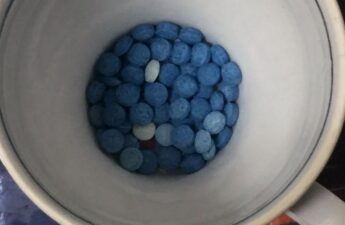
By Shefali Luthra, Kaiser Health News
Shannon Wood Rothenberg walked into her annual physical feeling fine. But more than a year later, she’s still paying the price.
Routine bloodwork from the spring 2018 visit suggested anemia, of which she has a family history. Her doctor advised pills. After two months with no change, the doctor sent Rothenberg to a hematologist who could delve into the cause and infuse iron directly into her veins.
So last July, the 48-year-old public school teacher went twice to a cancer center operated by Saint Joseph Hospital in Denver, where she received infusions of Injectafer, an iron solution.
When the bill arrived in March, after prolonged negotiations between the hospital and her insurer, Rothenberg and her husband were floored.
The hospital had billed more than $14,000 per vial. Since her treatment was in-network, though, her insurance plan negotiated a much cheaper rate: about $1,600 per vial. She received two vials. Insurance paid a portion, but Rothenberg still owed the hospital $2,733, based on what was still unpaid in her family’s $9,000 deductible.
“I have twins who are going to college next year. I’m already a bit freaked out about upcoming expenses,” she said. “I don’t have $2,700 sitting around.”
About 9 million Americans on Medicare have gotten iron infusions each year since 2013, the first year for which data is available; that’s almost one for every five people covered by the government insurance program for people over 65.
Anemia, the principal outgrowth of low iron levels, can cause headache, fatigue and irregular heartbeat. People with certain medical conditions, such as inflammatory bowel disease and kidney failure, are prone to low iron levels and anemia, which can be severe.
In other countries, doctors usually would not be so quick to resort to iron infusions — especially in healthy patients like Rothenberg, who have no underlying disease and no obvious symptoms.
“It would be extremely unlikely that IV iron would be administered” in Britain, said Richard Pollock, a health economist at the London-based Covalence Research Ltd. who studies iron products.
But one key difference between this country and others is that American physicians and hospitals can profit handsomely from infusions. Under Medicare, doctors are paid in part based on the average sales price of the prescribed drug, which critics say gives them an incentive to pick the newer, more expensive option.
For those with private insurance, hospitals and doctors can mark up prices even more. Intravenous infusions, generally administered in a hospital or clinic, also generate a “facility fee.”
That creates a financial incentive to favor the most expensive infused treatments rather than pills or simple skin injections that patients can use readily at home.
Indeed, a Kaiser Health News analysis of Medicare claims found that Injectafer and Feraheme — the two newest (and priciest) infusions on the American market — made up more than half of IV iron infusions in 2017, up from fewer than one-third in 2014. Cheaper, older formulations — which can go for as little as a tenth of the cost — have seen their share of Medicare claims fall dramatically.
Situations like these, which drive up Medicare spending, are why the Trump administration has suggested changing how Medicare pays for intravenous drugs. The administration would tie reimbursements for some IV drugs to the price paid in countries that set drug prices at a national level, in part based on an estimate of their comparative value. This plan has generated sharp backlash from conservative lawmakers and the medical and pharmaceutical industries.
Physicians argue that they simply prescribe the most effective medication for patients, regardless of what the payment system would suggest.
But stories like Rothenberg’s, expert research and the government’s own Medicare claims data paint a different picture.
“When there’s a financial incentive … that might move the physician away from the choice the patient would optimally make, we might be concerned,” said Aditi Sen, a health economist at Johns Hopkins Bloomberg School of Public Health, who is researching how doctors prescribe and are paid for intravenous iron treatments.
The example of iron, she added, suggests “a clear financial incentive to prescribe more expensive drugs.”
The Iron Market
Treatments for iron deficiency are nearly 100 years old. Geritol, a decades-old dietary iron supplement for “iron-poor tired blood,” was among the first medicines widely marketed through TV ads in the 1950s and ’60s.
The first federally approved iron infusion come to the U.S. market in 2000 — but these treatments have since surged in popularity. For one thing, infusions carry fewer side effects than do pills, which can cause constipation or nausea. And scientific advances have mitigated the risks of intravenous iron, although getting infusions still comes with inconvenience, some discomfort, and the risk of infection at the IV site and serious allergic reactions.
Now, five branded products dominate the American market for IV iron, and three have generic counterparts. They have different chemical formulations but by and large are considered mostly medically interchangeable.
“There’s not a huge amount of any difference in the efficacy of iron formulations,” said Pollock. So, for value, “the question really does come down to cost.”
Doctors are supposed to recommend infusions only if patients don’t respond to iron pills or dietary changes.
Instead of steering patients toward “unnecessarily costly” infusions, he said, physicians should determine the underlying cause of low iron and treat that directly.
Injectafer, which Rothenberg received, is one of the most expensive infusions, retailing for more than $1,000 a vial — though hospitals can charge privately insured patients whatever they choose, resulting in her sky-high bill. Insurers then negotiate that hospital “list price” down.
An analysis of private insurance claims conducted by the Health Care Cost Institute, an independent research group funded by insurers, found that in 2017 private health plans on average paid $4,316 per visit if a patient received Injectafer infusions. Feraheme, the next most expensive infusion drug, cost private plans $3,087 per visit, while the other three on the market were considerably cheaper. Infed was $1,502, Venofer $825 and Ferrlecit $412, the institute found in its analysis for KHN.
The share of newer, pricier infusions has crept up in the private market as well as in Medicare. In 2017, 23% of privately billed iron infusion visits involved Injectafer or Feraheme, compared with 13% in 2015, according to the HCCI data.
Nobody told Rothenberg cheaper options might exist, or warned her about the price, she said. The hematologist who treated her did not respond directly to requests for comment.
But Alan Miller, the chief medical director of oncology for SCL Health (Saint Joseph’s umbrella organization), told KHN that the hospital stopped using Injectafer in August 2018 — a month after Rothenberg’s visit — because of the patient cost burden. The hospital now uses Venofer and Feraheme.
There are some other reasons that doctors might choose the more expensive drug, experts say — not all strictly medical.
Newer, more expensive drugs are more likely to be heavily marketed directly to doctors, said Stacie Dusetzina, an associate professor of health policy at Vanderbilt University.
Walid Gellad, an associate health policy professor at the University of Pittsburgh, said some formulations may be more convenient in terms of how many doses they require, or how long patients have to sit for an infusion. Doctors might use the product they have most of in stock. A certain patient might have a distinctive profile that makes one drug an obviously better fit.
None of those explanations sit particularly well with Rothenberg, whose iron levels are now fine — but who is paying off her $2,700 bill over two years in installments.
“If they had said, ‘This is going to cost you $3,000,’ I would have said, ‘Oh, never mind,’” she said. “It’s a big mental shift for me to say I’m supposed to weigh the costs against the health benefits. I’m not supposed to necessarily do what the doctor says.”


